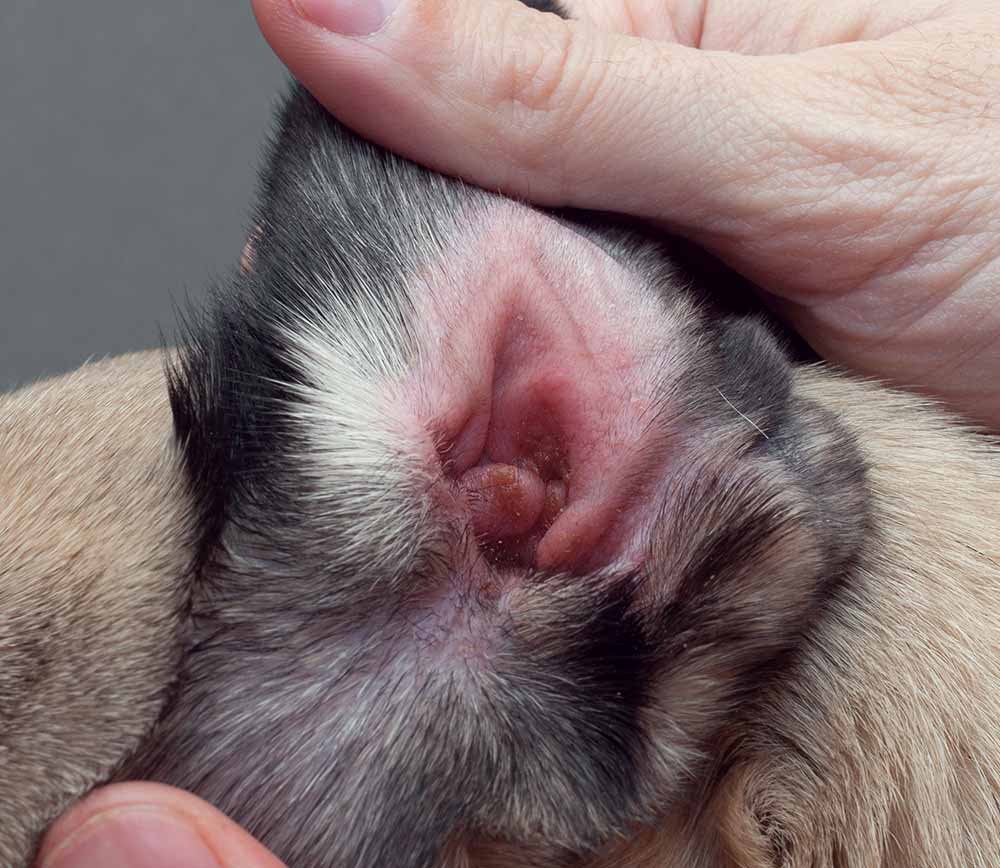
Skin conditions are notoriously the most common reason a dog will come to see a vet. For most of the patients I see for these issues, their skin will be both red and itchy. Frustratingly, this sort of skin complaint does not always have an obvious cause and may take some time to get under control.
We cannot always ‘cure’ red and itchy skin and some dogs will be prone to flare ups throughout their life.
One of the most important things I’ll do when I first see an owner about their dog with red and itchy skin is to manage their expectations: stopping all symptoms for good is not always a realistic outcome. The first step, is to determine what has triggered this red and itchy skin.
Top reasons for “red and itchy” skin
One of the more frustrating things about itchy, red skin is that there can be a huge array of causes and it is not always obvious what is going on. As a vet, I try to look at the bigger picture, assessing things like the dog’s age and breed but also any recent changes in their diet or environment. Top conditions leading to red and itchy skin include:
1. Environmental allergies (Atopic dermatitis)
I generally diagnose allergies in patients who are younger than five years of age, many of whom will be pedigrees such as Frenchies, Bulldogs, Westies and Labradors. They can be itchy anywhere, but the most commonly affected places include the groin, armpits, belly and paws.
With environmental alleriges, we might also see:
- fur loss
- scabbing, crusts and secondary infections.


Allergies can develop at any time up until about the age of five, and can be due to things (like pollen, dust mites or foods) that the dog previously tolerated.
Learn more about skin issues due to Environmental Allergies.
2. Fleas
Even in those who are regularly treated for parasites, we should never discount parasites as a possible cause for a new itch. Those who have a flea allergy dermatitis, for example, can react to a single flea bite. Dogs who co-habit with cats are often affected, though dogs can also pick up fleas from other cats or from the grass.



We may see the fleas or flea dirt when we comb our dogs, but this is not always the case, as some very itchy dogs will groom off any evidence before we have a chance to see it. Itching tends to be worst over the rump and flanks and many dogs will have fur loss and crusty skin above their tail base.

The aim is to eliminate contact with fleas((Veterinary Dermatology: Therapy, control and prevention of flea allergy dermatitis in dogs and cats)). Owners can treat fleas from home using an effective product (such as a spot on containing Fipronil or Imidacloprid) on all cats and dogs. They must also deep clean the home, hot wash the bedding and should consider a flea spray which contains an insect growth regulator.
Learn more about Flea Allergy Dermatitis.
3. Bacterial or fungal skin infection
Skin infections can lead to fur loss, pink or red skin, crusting, scabs and oozing. Bacterial infections tend to cause more itchiness than fungal infections, though there are exceptions. For many dogs, skin infections are actually a secondary issue, and are caused by e.g. parasites, allergies or hormonal disorders.



While we can see infections anywhere on the dog, areas that become moist and humid are more often affected and this can include the armpits, groin and paws. Owners can help from home by limiting licking (usually achieved with a buster collar), using medicated washes and addressing the primary issue.
A vet visit is advised so the vet can examine the skin and identify the type of infection present. This may include looking at the skin to check for fungi with a Wood’s Lamp and/or taking a fur pluck or skin swab. Dogs may need a course of antibiotics or anti-fungals as well as a wash such as Malaseb.
Learn more about Skin Infections in Dogs (Bacterial or Fungal).
4. A contact reaction to e.g. nettles or a cleaning product
If your dog has managed to rub or brush against an irritant, this can quickly lead to intense itching and red skin. As the paws and belly are the most likely places to be brushed against, they are usually affected. The itchiness can be intense but is often short-lived.

Owners should bathe the skin well with soapy, warm water to remove any irritant that remains. They may also consider giving some antihistamines, after discussion with their vet if this would be appropriate. It is wise to use a buster collar to protect the skin from excess chewing, and a food puzzle or chew can act as a good distraction from the itch.

5. Mites
Mange causes intense itching as well as red skin, crusting and scabbing which is frequently found on places like the ear margins and elbows.

If mange is suspected, an immediate vet visit is advised. A skin scrape and/or blood test can diagnose the issue and dogs will be issued with a mite treatment and may also receive some medicated washes. Fluralaner is one example of a very effective oral treatment((Efficacy of orally and topically administered fluralaner – Bravecto® – for treatment of client-owned dogs with sarcoptic mange under field conditions, Chiummo et al)). As mange can transmit to humans, we need to be cautious around the dog and practice good hygiene.
Learn more about Mange/Scabies.
How to help a dog with a red itchy skin
Before rushing your dog to the vet, there are usually some things that can be done from home to manage symptoms when they first arise.
This can include:
- Preventing skin damage with a buster collar, and by trimming claws short
- A soothing bath with a hypoallergenic shampoo or one containing ingredients such as oatmeal
- Distraction techniques like going for walks and offering food puzzles
- Bathing any red skin with salt water or a dilute solution of Chrlohexidine
- Anti-histamines such as Chlorphenamine, Cetirizine or Diphenhydramine. These should only be administered after discussion with your vet.
- Ensuring your pooch is up to date with their parasite prevention
- Checking the home and garden for any potential irritants
When to consult a vet for red and itchy skin in dogs
If the itching is not resolving shortly, the skin is broken or your dog is unsettled, it is wise to schedule an appointment. This is especially true if you cannot identify a reason for the itching.
However, if your dog starts to scratch and you see fleas, you may treat the fleas and monitor things from home. As long as the skin is not broken or infected, signs may soon resolve, without further action.
Why you should identify the issue early
When it comes to itchy skin, delaying treatment can mean that the skin becomes infected and the issue is harder to treat effectively. For this reason, we should contact our vet if the itching is persisting more than a day or two.
Also, being itchy has a truly negative impact on your dog’s quality of life and is something we should be trying to get under control rapidly.
Products you can use to help a dog alleviate red itchy skin
Soft Buster Collar
Something that you should always have at home, is a well-fitted and comfortable buster collar. This can be put on right away if your dog is licking or chewing their skin, preventing the skin from becoming broken and reducing the risk of infection.
Dogs usually prefer softer cones to plastic ones, as they are more comfortable for sleeping on. The most important time to use one is when the dog is unsupervised, for example when left alone or at night time. As dogs dislike wearing them, we should just use them as a ‘stop gap’ while we address and treat the cause of the itching.
Skin supplements
Skin supplements which contain ingredients like omega fatty acids and Vitamin E can be useful for managing red and itchy skin, alongside other therapies. They can help contribute to a healthier skin barrier, prevent moisture loss and may reduce inflammation.
Most dogs enjoy the taste and they’re easy to give in the diet each day. Side effects are uncommon and they’re inexpensive, so they are generally worth trying.
These chews contain both Salmon Oil and Flaxseed, which are rich source of essential fatty acids that can help reduce itching and inflammation (3).1
- The information below is per-pack only
Your visit at the vet
Questions your vet will ask you
Your vet will want to know all about your dog’s history and if they are prone to red and itchy skin. They’ll also question your dog’s parasite prevention, home life and diet. The vet will want to know about how long the issue has persisted and how it is impacting on your dog. If you’ve tried anything from home (whether it has helped or not), make sure to mention it.
What you should know before your visit
It is a great idea to keep a ‘reaction diary’ which documents your dog’s ‘itch score’ each day and also includes information like what they’ve eaten and where they’ve been.
It may be useful to have photos of your dog’s skin when it is especially flared up or videos of them when they are really itchy.
Diagnosis & cost of diagnosis
Diagnosis is sometimes based on your dog’s signs and clinical history alone. However, your vet may well run some further tests including a flea comb, skin scrape ($50-100) and swabs ($100-200).
For those with ongoing allergies, your vet might discuss the option of allergy blood tests. Allergy testing can be cost prohibitive to some, as tests can cost from $500-1,000.
References
1. https://onlinelibrary.wiley.com/doi/abs/10.1046/j.1365-3164.2000.00204.x
2. https://link.springer.com/article/10.1186/s13071-020-04395-6
3. https://onlinelibrary.wiley.com/doi/abs/10.1111/j.1748-5827.2004.tb00238.x
- Effect of omega-3 fatty acids on canine atopic dermatitis, Mueller et al. [↩]
Disclaimer: This website's content is not a substitute for veterinary care. Always consult with your veterinarian for healthcare decisions. Read More.




Be the first to comment